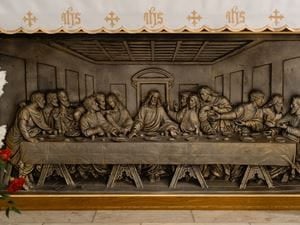
Twelve men answered the call to be Jesus’ disciples. They were uneducated commoners, Jews, and men of faith who sacrificed everything to be followers of Christ. Jesus spent three years training these disciples to be leaders. He planned to eventually have the disciples take over and carry on the work He started.
Jesus chose unrefined and ordinary men to be His disciples, who were the commonest of the common. They were farmers and fishermen from rural areas. Jesus purposefully passed over the aristocratic, influential and elite men of society and chose men from the dregs of society. That’s how it’s been in God’s economy. He praises the humble and lays low the proud.
Who were the 12 disciples?
Matthew 10:2-4 lists the original disciples as Simon, who is called Peter, and Andrew, his brother, James, son of Zebedee and his brother John. Then, there’s Philip, Bartholomew, Thomas, Matthew, the tax collector, James, son of Alphaeus, Thaddeus, Simon, and Judas Iscariot, who eventually betrayed Jesus. Matthias would replace Judas after his betrayal.
The apostles weren’t the kind of group you would expect Jesus to send forth on His mission to reach the world. There wasn’t anything spectacular or incredibly unique about them. They were ordinary working men. However, Jesus took these ordinary men to form the backbone of the church, giving them the most extraordinary job: calling the world, including the most powerful empire known to man, to repent and have faith in Christ.
You can bet that any first-century, educated Roman citizen would laugh off any prediction that the Christian faith would be the empire’s official faith within three centuries.
The dispersal of the disciples.
Book Three of the Church History of Eusebius says that Jesus’ disciples were dispersed worldwide. Thomas went to Parthia to spread the word, Andrew went to Scythia, and John went to Asia, where he lived for some time and died in Ephesus. Peter preached in places like Galatia, Bithynia, Pontus, Cappadocia, and Asia to the Jews of the dispersal. Eventually, he came to Rome.
Many people question how the 12 disciples died, but the New Testament only shares the fate of two of the disciples. Judas, who betrayed Jesus, hung himself, while James, the son of Zebedee, was executed by Herod in 44 AD, according to Acts 12:2.
How did the disciples die?
Though legends and reports abound, they’re not always reliable, but it’s safe to say that the disciples went far and wide to spread the message of Jesus Christ. One early legend says they cast lots to divide the world to figure out who would go where so everyone could hear Jesus’ message. They suffered greatly for their faith and often met violent deaths due to their bold faith and witness in Jesus Christ.
Paul and Peter.
During the persecution under Emperor Nero, Peter and Paul were martyred in Rome around 66 AD. Paul was beheaded, but Peter was crucified upside down at his request. He didn’t feel worthy to die in the same way Jesus did.
Andrew.
It’s believed that Andrew went to the “land of the man-eaters” in present-day Russia. Christians there believe he was the first to bring the gospel to their land. However, Andrew also preached in modern-day Turkey, Asia Minor, and Greece, where it’s believed he was crucified.
Thomas.
Thomas was likely the most active in the area east of Syria. Tradition says that he preached as far as India, where the ancient Marthoma Christians see him as their founder. They say he died when the spears of four soldiers pierced through him.
Philip.
Philip likely had a powerful ministry in Asia Minor and Carthage in North Africa, where he converted a Roman proconsul’s wife. As retaliation, the proconsul had Philip arrested and put to death.
Matthew.
Matthew was a tax collector and writer of a gospel who ministered in Ethiopia and Persia. Some of the oldest reports say he wasn’t martyred, but others believe he was stabbed to death in Ethiopia.
Bartholomew.
Bartholomew had extensive missionary travels attributed to him by tradition: to Ethiopia, India with Thomas and back to Armenia and Southern Arabia. However, various accounts say he met his death as a martyr for the gospel.
James.
James was the son of Alpheus and one of the last three James mentioned in the New Testament. There’s some uncertainty about which is which, but this James is believed to have ministered in Syria. The Jewish historian Josephus reported that he was clubbed and stoned to death.
Simon the Zealot.
Simon ministered in Persia but was killed after refusing to sacrifice to the sun god.
Judas.
Judas hung himself after he betrayed Jesus.
Matthias.
Matthias was the disciple chosen to replace Judas. Tradition says he was sent to Syria with Andrew to die by burning.
John.
John is one of the only disciples who’s commonly thought to have died a natural death from old age. He was a church leader in Ephesus and is believed to have cared for Mary, Jesus’ mother, in his home. During Domitian’s persecution, John was exiled to the island of Patmos, where it’s believed he wrote the last book of the New Testament, Revelation. One early Latin tradition says he escaped unharmed after being cast in boiling oil in Rome.
The influence of the disciples.
The name of Jesus’ disciples have become the most common name for men in the Western world. How many men are named Andy, John, Pete, Phil, or Jim? Four of the apostles were fishermen. Could this be part of the reason why one of the earliest Christian symbols was the fish? Icthus, the Greek word for fish, formed a puzzle: lesous Christos Theou Uios Soter, which means “Jesus Christ, Son of God, Savior.”
After the apostles’ death, we don’t find significant missionary figures of the prominence of Paul. However, the faith continued to spread, even when Christianity was deemed illegal until Emperor Constantine’s rule in the fourth century. Though the disciples were ordinary men, Jesus called them to do something extraordinary, and they completed their tasks.

